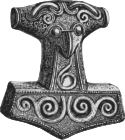- Svartálfar and Svartálfaheimr
-
In Norse mythology, svartálfar (Old Norse "swart elves" or "black elves", singular svartálfr) are beings who dwell in Svartálfaheimr (Old Norse "world of the swart elves" or "world of the black elves"). Both the svartálfar and Svartálfaheimr are solely attested in the Prose Edda, written in the 13th century by Snorri Sturluson. Scholars have noted that the svartálfar appear to be synonymous with dwarfs and potentially also the dökkálfar (Old Norse "dark elves").
The Svartálfar and Svartálfaheimr are solely attested in the Prose Edda, in which they are mentioned in two books; Gylfaginning (Svartálfaheimr) and Skáldskaparmál (svartálfar). In chapter 33 of Gylfaginning, the enthroned figure of High tells of the binding of the wolf Fenrir. High relates that when Fenrir had grown so large that the gods began to grow concerned, the god Odin sent the god Freyr's messenger Skírnir down to Svartálfaheimr to "some dwarfs" who made the silky yet immensely strong fetter Gleipnir from six fantastical ingredients. Whereas the other fetters failed, Gleipnir succeeds in binding the wolf.[1]
In chapter 35 of Skáldskaparmál, it is detailed that the half-god Loki once cut the lustrous golden hair of the goddess Sif, wife of the god Thor. Upon hearing of the shearing of his wife's locks, Thor, taking hold of Loki, intends to break every bone in Loki's body until Loki swears to get svartálfar to make "a head of hair out of gold that would grow like any other hair". Loki then goes to a group of dwarfs, the Sons of Ivaldi, who not only smith Sif's hair but also various other important objects owned by the gods, and the tale continues.[2]
Scholars have commented that, as both attestations mentioning the beings and location appear to refer to dwarfs, svartálfr and dwarf may simply be synonyms for the same concept.[3] Scholar John Lindow comments that whether the dökkálfar and the svartálfr were considered the same at the time of the writing of the Prose Edda is also unclear.[4]
Notes
References
- Faulkes, Anthony (trans.) (1995). Edda. Everyman. ISBN 0-4608-7616-3
- Lindow, John (2001). Norse Mythology: A Guide to the Gods, Heroes, Rituals, and Beliefs. Oxford University Press. ISBN 0-19-515382-0
- Orchard, Andy (1997). Dictionary of Norse Myth and Legend. Cassell. ISBN 0-304-34520-2
- Simek, Rudolf (2007) translated by Angela Hall. Dictionary of Northern Mythology. D.S. Brewer. ISBN 0-85991-513-1
Elves Germanic mythology
and Germanic paganismCategories (Dökkálfar and Ljósálfar · Half-elf · Svartálfar) · Figures associated with (Freyr · Völundr) · Locations (Álfheimr · Svartálfaheimr) · Religious practices (Álfablót)Modern influence See also Personifications and cosmology in Norse mythology Astronomical bodies Sun: (Sól · Árvakr and Alsviðr) · Moon: (Máni · Hjúki and Bil) · Earth: (Jörð · Fjörgyn and Fjörgynn) · Aurvandil
Time Worlds Nine Worlds: (Álfheimr · Asgard · Svartálfaheimr · Midgard · Múspellsheimr · Niðavellir · Niflheim · Jötunheimr · Vanaheimr) · Connected by the tree YggdrasilOther Norse paganism Deities,
heroes,
and figuresOthersAsk and Embla · Dís (Norns · Valkyries) · Dwarf · Einherjar · Elves (Light elves · Dark elves) · Fenrir · Hel · Jörmungandr · Jötunn · Sigurd · Völundr · Vættir
Locations Asgard · Bifröst · Fólkvangr · Ginnungagap · Hel · Jötunheimr · Midgard · Múspellsheimr · Niflheim · Valhalla · Vígríðr · Wells (Mímisbrunnr · Hvergelmir · Urðarbrunnr) · YggdrasilEvents Sources Society See also Categories:- Elves
Wikimedia Foundation. 2010.
